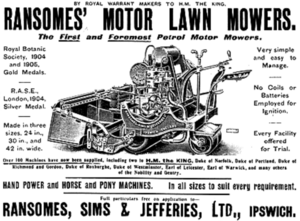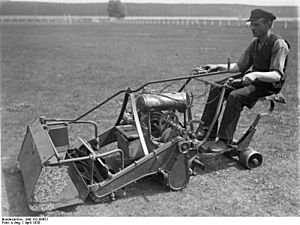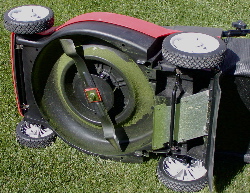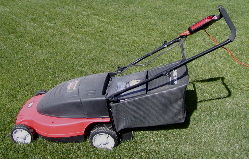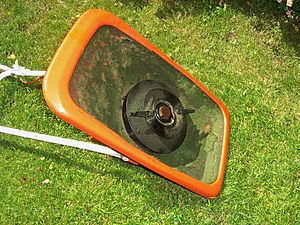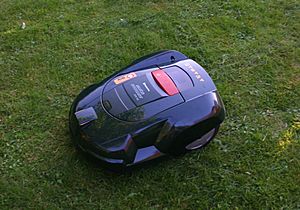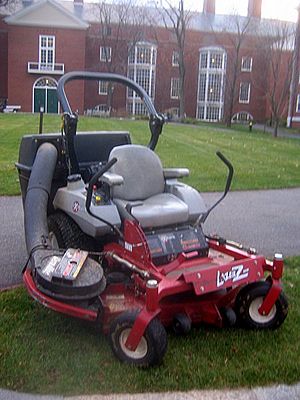Lawn mower facts for kids
A lawn mower is a machine with blades that cut grass on a lawn. Some lawn mowers are small and pushed by people, perfect for small yards. Larger ones are called ride-on mowers, and they are great for bigger lawns. The biggest mowers are pulled by a tractor and are used for huge areas like golf courses or parks. Remember to always wear safety gear when using these machines!
A lawn mower works by spinning a sharp blade or a strong piece of cable very fast. This action cuts the grass and other plants, making the lawn neat and tidy.
The Story of Lawn Mowers
Early Mowers: Cylinder Mowers
The very first lawn mower was invented by Edwin Beard Budding in 1827 in England. He got a patent for it in 1830. Budding's mower was made to cut grass on sports fields and fancy gardens. It was a much better way to cut grass than using a scythe (a long, curved blade on a stick).
It took about ten more years to make a mower that animals could pull. Sixty years later, the first steam-powered lawn mower was built!
In 1859, Thomas Green made the first mower that used a chain to turn its blades. By the 1860s, many companies started making lawn mowers. In 1870, Elwood McGuire designed a lightweight mower that people could push. It was very popular.
Around 1900, a well-known English mower was the Ransomes' Automaton. After World War I, JP Engineering made popular chain-driven mowers. At this time, people could even ride behind animals that pulled the big mowers. These were the first riding mowers!
Lawn mowers became more popular as lawn sports grew. They were much better than using a scythe or letting animals eat the grass. In 1893, James Sumner patented the first steam-powered lawn mower. It ran on gasoline or kerosene. After many improvements, these machines were sold by different companies.
After 1900, many companies started making gasoline-powered mowers. The first grass collectors were flat trays, but they got their current shape in the 1860s. The roller-drive lawn mower hasn't changed much since about 1930. Large mowers with many sets of blades, called gang mowers, were first built in the United States in 1919.
Modern Mowers: Rotary Mowers
Rotary mowers were developed later, once engines became small and powerful enough. Many people experimented with rotary blades in the late 1920s and early 1930s. Power Specialties Ltd. introduced a gasoline-powered rotary mower.
The Victa company started making rotary mowers in 1952. These mowers were lighter and easier to use than the older types.
Kinds of Lawn Mowers
By How They Cut
Cylinder (Reel) Mowers
A cylinder mower has a fixed, horizontal blade at the bottom. Above this, a fast-spinning reel of blades pushes the grass against the fixed blade, cutting it. Each blade on the reel is shaped like a spiral.
A cylinder mower makes the cleanest cut, which helps the grass heal faster. The cutting action is like scissors. The spinning blades don't even need to touch the bottom blade if the gap is smaller than the grass thickness.
There are many types of cylinder mowers:
- Push mowers have no motor. You push them, and the wheels turn gears that spin the blades. They are good for small lawns.
- Gang mowers are several push mower mechanisms pulled behind a tractor. They are used for large areas like sports fields.
- Some reel mowers have a gasoline engine or electric motor to power the blades or wheels. Electric models can have a cord or be cordless.
- Greens mowers are used for golf greens. They have a large roller that smooths the grass after cutting.
- Riding reel mowers let the operator sit on the machine. The cutting reels are usually in front of the wheels so the grass is cut before the wheels flatten it.
Rotary Mowers
A rotary mower has a blade that spins around a vertical pole, like a propeller.
By Power Source
Gasoline Mowers
Most rotary push mowers use internal combustion engines, which run on gasoline. These engines usually have one cylinder and range from about 2 to 7 horsepower. They often start with a pull cord, but some have an electric start button.
Gasoline mowers are powerful and can cover a large area. However, they create some pollution and need regular check-ups, like cleaning the spark plug and air filter.
Electric Mowers
Electric mowers are quieter than gasoline mowers, usually making less than 75 decibels (a measure of sound). Gasoline mowers can be much louder, over 95 decibels. Electric mowers also often have a safety switch that stops the motor right away if you let go, making them safer.
Corded Electric Mowers
Corded electric mowers have a power cord, which limits how far you can go (usually about 100-150 feet from an outlet). A risk with these mowers is accidentally cutting the power cord, which can stop the mower and give you an electric shock. Using a safety device on the outlet can reduce this risk. Corded electric mowers are usually cheaper to run and have less impact on the environment than gasoline mowers.
Cordless Electric Mowers
Cordless electric mowers run on rechargeable batteries. More batteries usually mean longer run time or more power. The batteries can be inside the mower or on the outside, so you can swap them for charged ones. Cordless mowers are easy to move around, like gasoline mowers, and are good for the environment, like corded electric ones. However, they are usually more expensive.
Other Types of Mowers
Hover mowers are push mowers that float on a cushion of air. A fan above the blades blows air downwards, lifting the mower off the ground. This makes it easy to push. Hover mowers are light and often have plastic bodies and electric motors. However, they can be hard to use on bumpy ground or at the edges of lawns because the air cushion can escape.
A robotic mower is a smart machine that mows your lawn by itself! It stays within a border wire placed around the lawn. The robot uses this wire to know where to mow and where its charging station is. Robotic mowers can cut grass in areas up to 5 acres. They are becoming very advanced, often charging themselves and having rain sensors, so you barely need to do anything. You can even use several robotic mowers for very large areas.
Riding mowers are popular for large lawns. The person operating it sits on the machine and drives it. Most riding mowers use the horizontal spinning blade system, often with several blades.
A common type of riding mower is the lawn tractor. These look like small farm tractors, with the cutting part in the middle, between the front and back wheels.
Riding mowers can have different ways of moving. The most common is a manual transmission (like a car with gears you shift). Another common type is a hydrostatic transmission, which is easier to use and can send more power to the wheels. Electric riding mowers are the most expensive.
Riding lawnmowers can also have other tools attached, like snowplows, snowblowers, or yard vacuums.
The body of a rotary mower is usually made of steel. More expensive models use stronger steel or aluminum, which doesn't rust. Some electric mowers have plastic bodies, which are light and don't rust.
Riding mowers usually have an opening where the cut grass comes out. Some have a bag attached to collect the grass clippings.
Special mulching blades are available for rotary mowers. These blades chop the grass clippings into very small pieces. This saves you from collecting and throwing away the clippings. It also creates natural compost for your lawn, which can save you money on fertilizer.
Mower companies sell different types:
- Side discharge mowers shoot the grass out the side.
- 2-in-1 mowers can bag the grass or mulch it (chop it finely).
- 3-in-1 mowers can bag, mulch, or side discharge.
Most 2-in-1 mowers need an extra part to discharge grass onto the lawn. Some side discharge mowers can be changed into mulching mowers with a special cover and blades. However, 2-in-1 or 3-in-1 mowers are much easier to switch between modes.
There are two main types of bagging mowers:
- A rear bag mower has an opening at the back where grass goes into the bag.
- Hi-vac mowers have a tunnel from the side to the bag. This type is also used on riding lawn mowers and is thought to be more efficient.
Mulching and bagging mowers don't work as well on very long grass or thick weeds.
Images for kids
-
Noise level from a lawn mower measured using the NIOSH Sound Level Meter app
-
An Ursus tractor-pulled mower.
See also
 In Spanish: Cortacésped para niños
In Spanish: Cortacésped para niños


